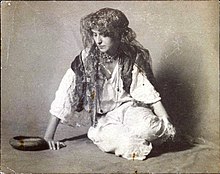Muslim Romani people
| Part of a series on |
| Romani people |
|---|
|
Romani people by sub-group |
|
Romani diaspora by country
|


Muslim Romani people are people who are ethnically
Muslim Roma hold
Settlings
After the collapse of the Ottoman Empire, the Muslim Roma have found themselves under double discrimination in regions where Islam was a minority religion, experiencing both
At the Greek War of Independence, Russo-Turkish War (1877–1878) and Balkan Wars (1912–1913), Muslim Roma flee together with other different Muslim Groups to Istanbul and East Thrace, as Muhacir.[25]
At the Population exchange between Greece and Turkey, Muslim Turkish Roma from Greece have also been resettled in Turkey. In Turkish, they are called Mübadil Romanlar.[26][27][28][29][30]
In 1950–1951 Muslim Turkish Roma from Bulgaria came to Turkey and settled in Çanakkale and surroundings.[31]
From 1953 -1968, Muslim Turkish Roma and Turks from Yugoslavia emigrated to Turkey,[32][33]
Because of the relative ease of migration in modern times, Muslim Roma may be found in other parts of the world as well. Turkish Roma from
Faith and status
Most Muslim Roma are Sunni, but they are not exclusively Sunni. For example, there are some Shia Roma communities in Serbia.[39] Turkish Roma are mostly Sunni.[40] Under Ottoman rule, Roma Muslim had a lower social status than non-Roma Muslims, but above that of non-Muslims.[41] However, other Muslim Roma are well-integrated with and accepted by their Muslim non-Roma brothers.
Types of Muslim Roma
Xoraxane
Arlije
The sedentary Arlije are the main group of the Romani people in North Macedonia. They are one of the many subgroups considered Xoraxane.
Crimean Roma
The Crimean Roma (also called Çingene) are a community of Tatarized Roma who traditionally practice Islam. They are often considered to be both a subgroup of the Roma and a subgroup of the Crimean Tatar people due to assimilation, although the term oraxane is rarely, if ever, used for them anymore
Zargari
The Zargari are a Roma subgroup settled in Zargar, Iran and neighboring villages who observe Shia Islam and speak in a Balkan Romani dialect. Their exact origins are debated among scholars.
New Muslims
British Romani businessman Alfie Best Jr. converted to Islam in 2023.[44] As Islam is not an ethnoreligion, it accepts converts regardless of their ethnic background, which includes Roma from non-Muslim backgrounds.
Dress
Muslim Roma women wear beautiful silk Dimije also known as Turkish salvar, at weddings, circumcision ceremonies, and other festivals. Even on weekdays, quite a few older women, but also some younger women, wear the şalvar.
Dance and music
Belly dance and Romano Hora (dance), Roman Havaları 8/9 tact, Zurna, Davul, Clarinet are performed. In the Ottoman Empire, especially young handsome Romani Guys were taken as Köçek-Dancers while young Romani female-dancers were named Çengi.[45]
See also
- Arlije
- Gurbeti
- Sepečides Romani
- Zargari tribe
- Kakava
- Turkish Romani
References
- ^ "Xoraxane Roma".
- ^ "Society: Macedonia's Romani Imam". Transitions Online (6/08). 2010.
- ^ "Quran Collection: The Noble Quran in Romani Language – (Juzz Amma) -... | Romani language, Noble quran, Romani".
- ^ YÖK Açık Bilim [dead link]
- ISBN 9781780232973.
- ^ Barutcu, Atilla (January 2015). ""Ucundan Azıcık"la Atılan Sağlam Temel: Türkiye'de Sünnet Ritüeli ve Erkeklik İlişkisi". Masculinities: A Journal of Identity and Culture.
- ^ "ROMANINET- A MULTIMEDIA ROMANI COURSE FOR PROMOTING LINGUISTIC DIVERSITY AND IMPROVING SOCIAL DIALOGUE : REPORT ON ROMA PEOPLE" (PDF). Romaninet.com. Retrieved 11 January 2022.
- .
- ^ "School holidays in Malaysia, time for circumcision". Reuters. 23 November 2009.
- ^ "Historic tradition of circumcision". Daily Sabah. 28 July 2017.
- ^ "KIRVELIK TRADITION IN DIFFERENT RELIGIOUS GROUPS: A RESEARCH ON THE TRANSFORMATION OF RITUAL KINSHIP".
- ^ Marushiakova, Elena. "Roma Muslims in the Balkans".
- ISBN 978-0-8108-5468-0.
- ^ "THE GYPSIES OF ISTANBUL | History of Istanbul".
- ISBN 0-86372-192-3
- ^ Ana Oprişan, George Grigore, "The Muslim Gypsies in Romania" Archived 5 March 2009 at the Wayback Machine, in International Institute for the Study of Islam in the Modern World (ISIM) Newsletter 8, September 2001, p.32; retrieved 2 June 2007
- ^ Rotaru, Julieta (1 January 2021). "CONSIDERATIONS ABOUT THE 'TURKISH GYPSIES' AS CRYPTO-MUSLIMS IN WALLACHIA". History and Culture of Roma. Festschrift in Honour of Prof. Dr. Vesselin Popov. ISBN/GTIN 978-3-96939-071-9. Retrieved 23 January 2022.
- ^ "Archived copy" (PDF). Archived from the original (PDF) on 27 July 2007. Retrieved 6 February 2009.
{{cite web}}: CS1 maint: archived copy as title (link) - ^ "The identity of a Gypsy community".
- S2CID 155028453 – via ResearchGate.
- ISBN 9781349646739.
- ^ "Ottoman Empire : Historical Sources about the "Gypsies" in the Empire". Rm.coe.int. Retrieved 11 January 2022.
- ^ "ROMA GROUPS | Център за междуетнически диалог и толерантност АМАЛИПЕ". Amalipe.bg. Retrieved 11 January 2022.
- ISBN 0-231-12475-9
- ^ "Expulsion and Emigration of the Muslims from the Balkans". Ieg-ego.eu.
- ^ Zeynep BİLGEHAN (11 March 2019). "Mübadil Romanların az bilinen hikâyesi". Hurriyet.com.tr.
- ^ "Unutulan Mübadil Romanlar: 'Toprağın kovduğu insanlar'". Kronos34.news. 7 February 2021.
- ^ "GEÇMİŞİN AYNASINDA LOZAN ÇİNGENELERİ: GÖÇ, HATIRA VE DENEYİMLER" (PDF). Sdergi.hacettepe.edu.tr. Retrieved 11 January 2022.
- ^ "Sepečides Romani-Project : History" (PDF). Rombase.uni-graz.at. Retrieved 11 January 2022.
- S2CID 146293564.
- ^ Mithat ATABAY. "Çingene Sorunu ve 1950–1951 Yıllarında Bulgaristan'dan Çanakkale'ye Göçler" (PDF). Acarindex.com. Retrieved 26 July 2022.
- ^ Nikolina Rajkovic. "The Post-Second World War Immigration of the Yugoslav Muslims to Turkey (1953–1968)" (PDF). Etd.ceu.edu. Retrieved 26 July 2022.
- S2CID 149846476.
- ^ "Arlije [Rombase]".
- .
- ISBN 9780520924277.
- ^ a b "Xoraxane Roma". www.romarchive.eu.
- S2CID 241338430 – via ResearchGate.
- ISBN 978-90-04-51897-1.
- ISBN 978-1-4744-1801-0.
- ISBN 978-90-04-51156-9.
- ^ "Xoraxane Roma". www.romarchive.eu. Retrieved 30 August 2023.
- ^ "Roma – Sub Ethnic Groups". Rombase.uni-graz.at.
- ^ "British billionaire Alfie Best Jr accepts Islam". 20 March 2023. Archived from the original on 20 March 2023.
- ^ Besiroglu, Sehvar. "Music, Identity, Gender: Çengi̇s, Köçeks, Çöçeks".
Further reading
- Roma Muslims in the Balkans by Elena Marushiakova and Vesselin Popov
